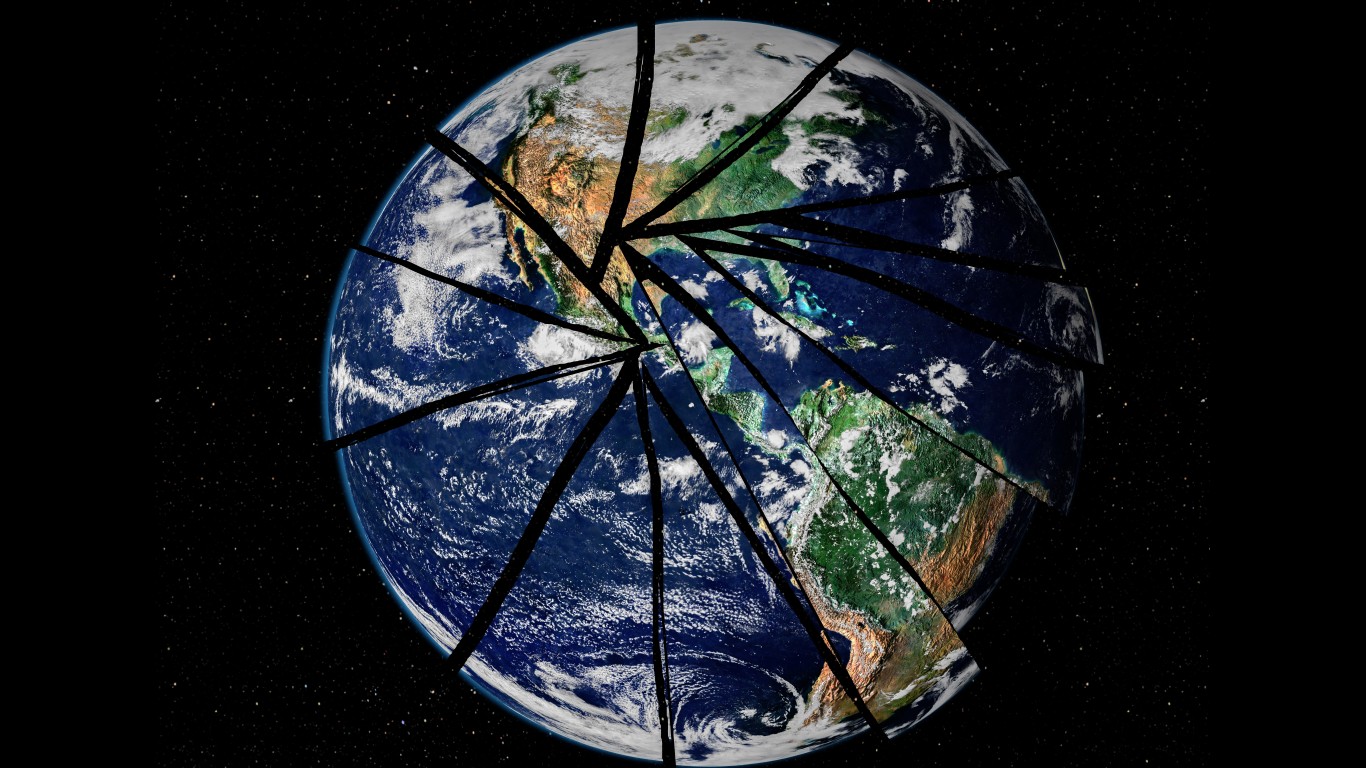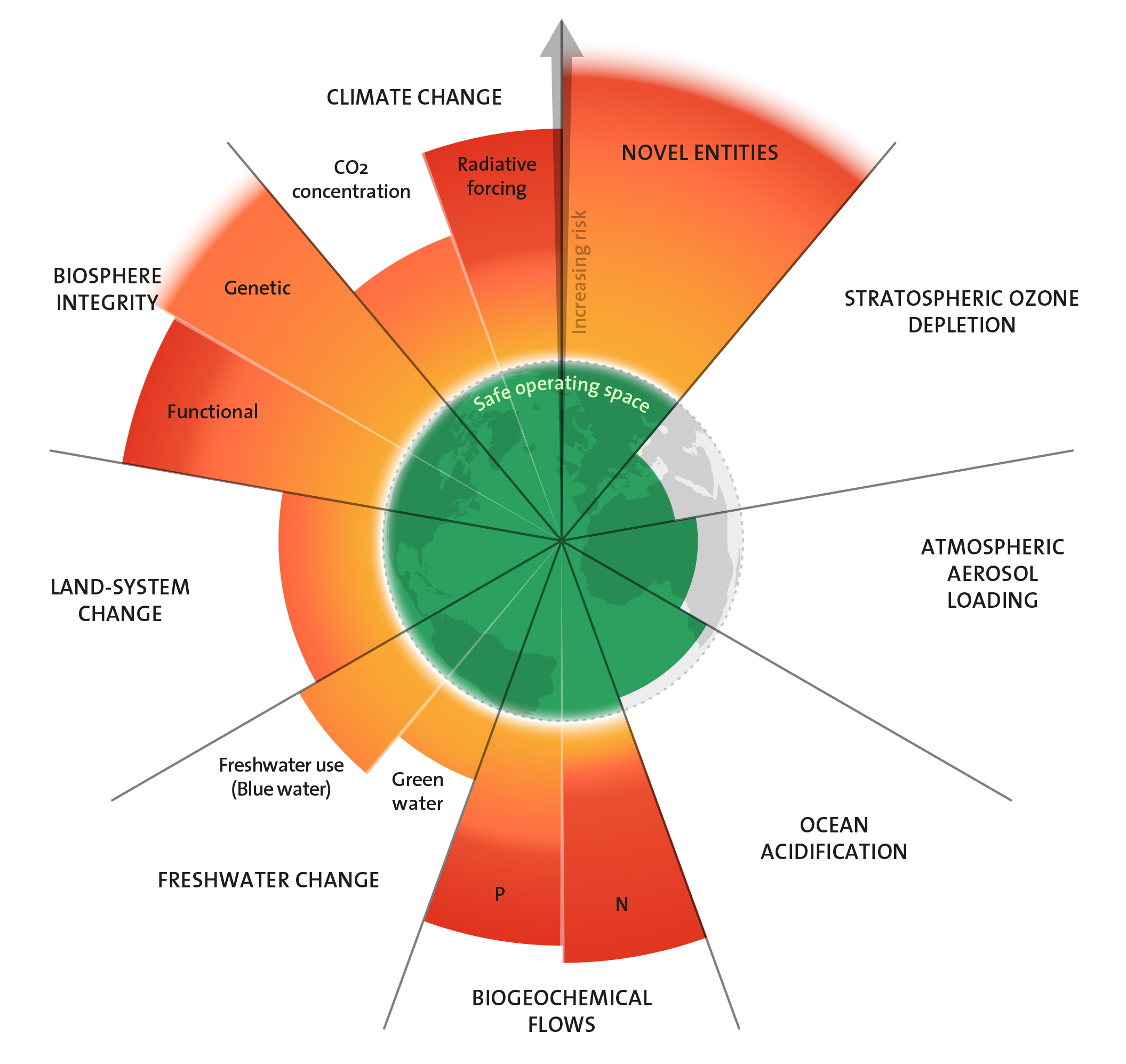
At the end of the last Ice Age, about 10,000 years ago, Earth developed systems that supported the environment and life-support systems, including the stability and warmth that the planet and its inhabitants have enjoyed for those millennia. That could be about to change.
An international team of scientists on Wednesday published an updated report in Science Advances on what is known as the planetary boundaries framework, the limits on nine processes that are “critical for maintaining the stability and resilience of Earth system as a whole.” At present, all nine are “heavily perturbed by human activities.”
The following illustration from the report shows the position of each of the nine framework processes in relation to the “safe operating space” depicted as the green-shaded Earth. Of the nine processes, six have exceeded their safe system limits: novel entities; climate change; biosphere integrity; land-system change; freshwater change; and biogeochemical flows. The other three (ocean acidification, atmospheric aerosol loading, and stratospheric ozone depletion) remain within safe limits, although ocean acidification is close to breaking through.
Note that boundary positions do not indicate or predict threshold shifts in Earth’s system state:
They are placed at a level where the available evidence suggests that further perturbation of the individual process could potentially lead to systemic planetary change by altering and fundamentally reshaping the dynamics and spatiotemporal patterns of geosphere-biosphere interactions and their feedbacks.
A co-author of the study, Johan Rockström, professor in environmental science at Stockholm Resilience Centre, commented: “We don’t know how long we can keep transgressing these key boundaries before combined pressures lead to irreversible change and harm.” In other words, we know these transgressions are the result of human activity but we do not know the point at which that activity will have passed the tipping point.
The study identifies climate change and biosphere integrity as core boundaries in the overall framework. Biosphere integrity has two parts: genetic diversity inherited through natural selection and functional integrity. Genetic diversity is measured by a boundary level of less than 10 species extinctions per million species-years and functional integrity is the “human appropriation of the biosphere’s net primary production expressed as a fraction of its net primary production since the last Ice Age, also known as the Holocene.”
Among the measurable climate change variables, “the most important anthropogenic [human-caused] impacts on Earth’s energy budgets are the emission of greenhouse gases and aerosols and surface albedo [the amount of light and heat reflected from Earth’s surface] changes. The less light and heat reflected back into space, the higher the albedo.”
The most well-known of the climate change metrics is the 1.5°C target for global warming by 2100 set by the Paris Agreement. That target infers an atmospheric carbon dioxide concentration of 350 parts per million, well below the current concentration of 447 parts per million.
According to a simulation run by the study’s authors, had the Earth remained at its 1988 operating state, “temperature over the global land surface would not have increased by more than an additional 0.6°C in the subsequent 800 years (and not >1.3°C compared to the preindustrial period).” In 1988, carbon dioxide levels had reached 350 parts per million, and the Earth’s remaining blanket of tropical, temperate, and boreal forests 85%, 50%, and 85%, respectively, been maintained, “essentially stable planetary conditions would have been maintained … within the safe operating space.”
Rockström gets the last word:
Science and the world at large are really concerned over all the extreme climate events hitting societies across the planet as we move through the third human-amplified El Niño in only 25 years. But what worries us, even more, is the rising signs of dwindling planetary resilience, manifested by the breaching of planetary boundaries, which brings us closer to tipping points, and closes the window to having any chance of holding the 1.5°C planetary climate boundary.
100 Million Americans Are Missing This Crucial Retirement Tool
The thought of burdening your family with a financial disaster is most Americans’ nightmare. However, recent studies show that over 100 million Americans still don’t have proper life insurance in the event they pass away.
Life insurance can bring peace of mind – ensuring your loved ones are safeguarded against unforeseen expenses and debts. With premiums often lower than expected and a variety of plans tailored to different life stages and health conditions, securing a policy is more accessible than ever.
A quick, no-obligation quote can provide valuable insight into what’s available and what might best suit your family’s needs. Life insurance is a simple step you can take today to help secure peace of mind for your loved ones tomorrow.
Click here to learn how to get a quote in just a few minutes.
Thank you for reading! Have some feedback for us?
Contact the 24/7 Wall St. editorial team.





